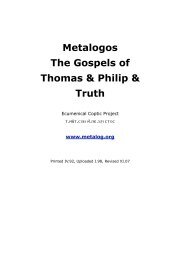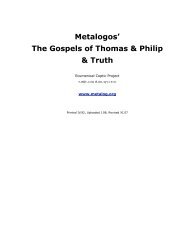Andrew Louth - Syriac Christian Church
Andrew Louth - Syriac Christian Church
Andrew Louth - Syriac Christian Church
Create successful ePaper yourself
Turn your PDF publications into a flip-book with our unique Google optimized e-Paper software.
LIFE AND TIMES 7<br />
Maurice’s daughter, regarded him as his father and protector. When,<br />
a decade later, Maurice was deposed and murdered, Chosroes seized<br />
the opportunity to avenge him by renewing the war with the Byzantine<br />
Empire. By 610, the Persian army, supported by Avar allies, had<br />
already reached Chalcedon, across the Bosphorus from<br />
Constantinople. The senators of the Queen City looked for help from<br />
Heraclius, the exarch of Carthage, who sent his son, also called<br />
Heraclius, with a fleet that reached Constantinople on 3 October.<br />
Phocas, the usurper and murderer of Maurice, was deposed and<br />
Heraclius crowned as Emperor by the Patriarch of Constantinople,<br />
Sergius. Chosroes refused a peace settlement, and so Heraclius spent<br />
the first eighteen years of his reign engaged in an ultimately<br />
successful war with the Persians.<br />
To begin with the Persians made the running: they conquered the<br />
Middle East—Syria, Palestine and Egypt—in 614 capturing Jerusalem<br />
and taking the relic of the True Cross, that had been rediscovered by<br />
the Empress St Helen, the mother of Constantine, in the fourth<br />
century. Eventually in 627 Heraclius led the Byzantine army from the<br />
north, through Mesopotamia, to the Persian capital, Ctesiphon, not<br />
far from modern Baghdad, where he recovered the relic of the True<br />
Cross. Chosroes was deposed by his son and murdered. The<br />
Byzantines quickly re-established their rule in the Middle East.<br />
Before this, however, the Persians with the support of the Avars and<br />
Slavs had laid siege to Constantinople. The defence of the city had<br />
been led by the Patriarch Sergius, who had carried the icon of the<br />
Mother of God around the city walls: the successful defence of the city<br />
was ascribed to the Mother of God, and the kontakion that<br />
now prefaces the older Akathist hymn was probably composed to<br />
celebrate this great deliverance, perhaps by Sergius himself. The<br />
changing fortunes of the <strong>Christian</strong>s in the Middle East in these two<br />
decades (610–30) exposed the dangers caused by the religious disunity<br />
of the <strong>Church</strong> of the Empire.<br />
BACKGROUND TO THE RELIGIOUS<br />
PROBLEMS OF THE BYZANTINE EMPIRE<br />
To understand the religious problems of the seventh century, it is<br />
necessary to go back even further, to the fourth century at least. From<br />
the very beginning <strong>Christian</strong>s had believed that Jesus stood in an<br />
especially close relationship to God the Father. In the course of the<br />
fourth century this relationship was defined by saying that the one<br />
who became incarnate as Jesus of Nazareth is ‘consubstantial’ (Greek:<br />
homoousios) with God the Father: that is, that he is God in exactly the<br />
same sense as God the Father is God, save that he derives his divine




